
|   |

|   |
Nartanam Conclave 2018 on Music in Dance: Part 1 - Lalitha Venkat e-mail: lalvenkat@yahoo.com Photos: Pranay Rupani October 19, 2018 The Sahrdaya Trust, publisher of the Nartanam quarterly, headed by scholar and chief editor Madhavi Puranam, hosted the second edition of the 4 day Nartanam Conclave on 'Music for Dance' from October 5 - 8, 2018 at the pleasant MCR HRD Institute of Telangana campus in Hyderabad. The mornings were devoted to lec-dems and paper presentations followed by one dance performance in the evening. In her keynote address, critic Manjari Sinha quoted Balasaraswathi: "People are mesmerized by the dance. They don't know that the magic lies in the music." She said gayan-vadan-nritya make a dance performance and every dance form is so diverse - Kathakali recalls sopanam music, Odissi recalls ashtapadis, Bharatanatyam recalls padams, varnams and thillanas. Music is the lifeline of dance and hence the subject of the morning seminar was apt. 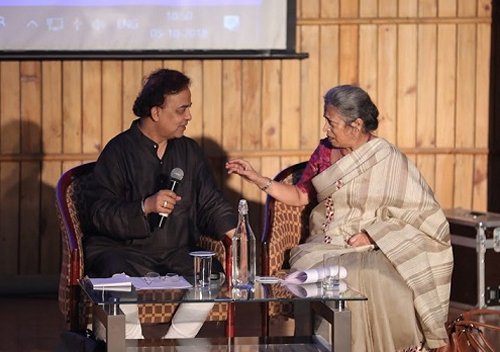
Jayant Kastuar and Shama Bhate
The first presentation of the conclave was 'The transitions in Kathak music since Independence' by Guru Shama Bhate, Nad Roop, Pune. The chair for this session, Jayant Kastuar (Former Secretary of the Sangeet Natak Akademi), said that nritya-sangeet-sahitya form the soul of dance. Bhakti tradition and music tradition gave an impetus to the dance styles. In Bharatanatyam, Kathak and Odissi, there is an emphasis on nritya apart from nritta. Nritta is not separately presented in Kathakali or Manipuri. Introducing Shama Bhate, he said she is "one of the outstanding disciples of an outstanding guru and has done outstanding work in the field of Kathak." Shama Bhate gave a very erudite presentation with apt examples of bol recitations and screened pertinent clips of dance for which music was exceptionally brilliant. She said in any performance, music is of prime importance. Pt Kishan Maharaj said of Birju Maharaj that his feet sing. The musicality in Maharaj's dance is in gestures, stances and footwork. A Kathak dancer wears 150 to 200 bells on each of his ghungroos that are never set to a particular tune. It's the demeanour of the dancer. Padhant has no particular sur as its basis. It depends on the composition. The padhant makes or breaks a bandish. The dancer in a way is a musician himself. Kathak has an open ended arrangement with no particular structure. There are lots of improvisations on stage in Kathak. The space for a Kathak presentation changed from temple to Darbar, to Kotha and then to proscenium stage. When Kathak came to the proscenium, the music also changed. The technical sound amplification changed drastically over the years. A fixed time duration and sophisticated tech changed the music patterns. The items are short, dance has become more flashy and aggressive with the tabla accompaniment. Shama spoke of the merits and demerits of recorded music. Recorded music is more in vogue now, but the dance performance loses its vibrancy, spontaneity and improvisation in a recorded score. Kathak presentations going on through the entire night shrunk to 2 - 3 hours and then to 40 minutes. "In a 40 minute time limit, we have lost the luxury of improvisation," said Shama Bhate. Since every minute has to be accounted for, there is hardly any opportunity for improvisation. While tabla players were always available, other musicians were not. Comparing live accompaniment and recorded music, Shama said laya and swara is maintained in the latter but missing cues and things going wrong are more in the former. While experimenting with different genres of music, like a Carnatic and Hindustani fusion showing thaat and bandish, such a blend is possible only in recorded music. Different sounds bring a different sensitivity to a dance form was demonstrated with a clip of gat to guitar and keyboard. Shama also mentioned adapting shelf music for dance. Three generations have passed since the time of Independence and the audience of today has different expectations. There was no TV or internet then and dance was conducted in an intimate space. The viewers' sensibilities have changed over the years. With global accessibility, every dance presentation has to compete with sophisticated, well presented shows. To adapt to the huge stage space now and resulting big audience for viewing, a group replaced a lone figure. Shama mentioned that while choreographing her mega production Mahabarath that featured different classical dance styles, authentic music for each style was possible only in recorded music. She said a true artist, especially a dancer who has sensitivity for music, would always improvise with or without live music score. Experiments with the potential of the form may sometimes not click. "I have studied music and it is my experiment. My main body of work is with traditional music. But I am trying to connect, relate with other sensitivities of music. This is my chance to show what we can do. There is an inherent scope in Kathak dance to experiment with music, space, theme, idiom and text without harming the traditionalism and classicism," concluded Shama. Summing up the session, Jayant Kastuar said, "Don't experiment with traditional music beyond a point. Certain types of music have come to be known as music for Bharatanatyam, Kathakali, Odissi or Kathak and its identity has to be maintained. It is taken for granted that Kathak uses Hindustani music. During the Muslim rule, bhakti music got sidelined. It has to be revived. The journey of Hindustani music and Kathak go side by side. Around 2001, SNA award for music for dance was created." Dr.Suresh Goel (former DG, ICCR) was of the view that any art cannot survive without interaction, without rasikas. 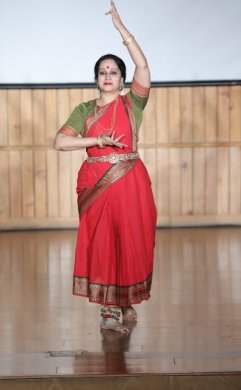
Anupama Kylash
Next was a lively and insightful lec-dem by Dr. Anupama Kylash (Anubhav centre for music and dance, Hyderabad) on 'The components of music in Vilasini Natyam' with Dr. Aruna Bhikshu (HOD of Sarojini Naidu School of Arts and Communication, Univ of Hyderabad) as chair. The ancient treatises which dealt with the subject of music, whether it was the Natya Shastra, the Dattilam, or the Sangita Ratnakara, have all stressed upon the interdependency of the 'word,' 'music' and 'dance' - after all, dance is music and music is dance. In Indian dance systems, therefore, literature, music and dance are inextricably woven together. Vilasini Natyam is the art of the hereditary temple dancers of the Telugu land. The Telugu kalavantulu were trained equally in dance and music, though some became dancers and some became musicians. Anupama elaborated on the musical components of Vilasini Natyam highlighting the variations of melodic and rhythmic structures in three contexts - Alaya Sampradayam (Temple tradition), Asthana Sampradayam (Court tradition), and Ata Bhagavatham (Operatic tradition) which is about honing one's skills to present to the audience. The music of all three contexts were analyzed in three categories - Laya or rhythm centric music; music as melodic refrain; music as applied to the different genres of literature. Explaining the ragas and talas of Vilasini Natyam, Anupama said they have lots of resemblance to Kuchipudi Yakshagana sampradaya. More than a song sung, it is like a dialogue sung. Rough singing of earlier years has been made more refined in later years, with its own identity of rendering. The music applied to Vilasini Natyam, while employing a wide range of ragas and talas, pays particular attention to the subtle nuances of 'raga bhava', 'tala, kala and laya auchitya' and 'prakriti nirupana.' Anupama said some of the archaic talas have been put to use in temple rituals. These prayers are in different meters. Many of the talas in the agamas are to be found in the desi talas. Some ragas are supposed to be the favourite of certain deities, like Shankarabharanam for Shiva. Rajachoodamani tala in Malahari is used to propitiate Yama. Pallavis are seen from age old times in Telugu devadasi tradition - swara pallavi, shabda pallavi and sahitya pallavi. Anupama demonstrated shabda pallavi in raga Manirangu and a salaam daruvu. Like in Bharatanatyam, varnam even in Telugu devadasi system is the central piece. Devadasis would sing the swarams and dance the abhinaya. Music or dance was manodharma in the padabhinaya. Anupama spoke about influence of western music - they were inspired by Celtic music, harmony based music, adapted to western music scales and called Company Javalis! - followed by a demo. The accompanists were Sweta Prasad on vocal, Renuka Prasad on mridangam and KLN Murthy on violin. The vivacious presentation was summed up by Dr. Aruna Bhikshu that dancers who can sing can be thinking dancers! The super finale was 'Components of music for Kuchipudi' by the superstar of music, vocalist D.S.V. Sastry, with Manjari Sinha as chair. Since Sinha chose to speak in Hindi despite Sastry requesting her to speak in English, there was no interaction between presenter and chair. Using Dr. Anuradha Jonnalagadda as interpreter (he was more comfortable speaking in Telugu), at the outset he said that he was born in Kuchipudi village where he spent time there with the great gurus and he was sharing these experiences, ideas and thoughts from personally having engaged with the art form of Kuchipudi for more than three decades and not as a culmination of any focused scholarly study. In addition to being fluent in Carnatic music and Yakshagana sangeetham, he is trained in Kuchipudi dance and nattuvangam and is a choreographer and music composer. Sastry's presentation explored the role of music in Kuchipudi as an art form, and how the music of the form has changed from the late 19th to early 20th century to the present times. The ragas employed, their relevance and usage in various situations and the manner of exploiting a jathi or a talam to portray rasas in Kuchipudi was discussed. Sastry feels that the music of Kuchipudi is a bani by itself and has an identity of its own, despite having adopted the tenets of Carnatic music. 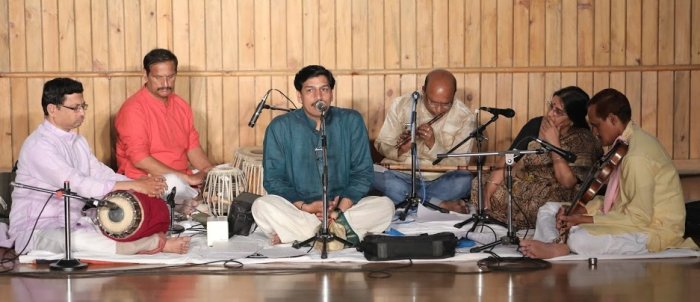 D.S.V. Sastry and group He said Kuchipudi music is set by the dancers themselves for the sahitya. It makes the music more special as it is based on the artiste's bhava. Kuchipudi dancers are known to do lots of experimentation. The song in praise of goddess Balatripurasundari starts with Mohana, goes to Kambhoji and comes back to Mohana ragam. Such prayogas are done to make the composition more interesting and appealing. Kuchipudi is essentially performed for the audience. Being a performative art form that depicts stories from mythology, Kuchipudi's music, like its lyrics, is one of its key tools of storytelling. From the time of the kalapam to the solo, one can observe a transformation in the music, though the core remains intact. A few defining features, which could be the musical structures or jathi patterns or choice of ragas itself, that form an underlying basis for the bani of Kuchipudi music, were discussed. It is not just the corpus of ragam or talam that forms the bani, but how the selected ragam or talam are employed in the composition. The tradition that has come down to us has as its source, the kalapam, specifically the Bhamakalapam. The structure of the daruvu is the most characteristic feature of Kuchipudi, and it is from this kalapam that we derive the daruvu structure, to the extent that even the daruvus that are created today are reminiscent of the daruvus from this kalapam. Following the kalapam, the music, along with the form, was enriched greatly by the Yakshagana Pitamaha, Chinta Venkataramayya. Sastry took some examples from Bhakta Prahlada Yakshagana and demonstrated the Hiranya pravesa daruvu that has the vachika abhinaya come in-between and merge with the music. Rendition of Amba Paraku and an excerpt of Bhamakalapam were greeted with rapturous applause! Sastry opined that the use of certain ragas create certain moods. He demonstrated how Arabhi raga that is generally a soft, soothing raga (used in Lekha of Sathyabhama) can also be used to show raudra rasa (Hiranyakashipu admonishing Prahlada). Sastry also sang a specially composed pravesa daruvu for Ghatothkacha. The lilting movements of churning the ocean in Ksheera sagara mathanam composed by P Sangeeta Rao conjured a vivid picture in the mind's eye. When Vempati Chinna Satyam began experimenting with the genre of dance drama in the later decades of the 20th century, he began commissioning talented musicians from outside the village of Kuchipudi. The dance drama began to take shape with the creative inputs of Balantrapu Rajinikantha Rao, Dwaram Bhavannarayana and Mallik. "But the musician who has been involved the most with music of Vempati's dance dramas and solos is Patrayani Sangeeta Rao. In fact, I would take the liberty to say that a large part of what defines Kuchipudi music today has been created by the genius of Sangeeta Rao," declared Sastry. "An interesting observation for me has been to notice that the music of Kuchipudi lyrics does not require the same ragam to be continued for an entire lyric, instances where the raga might suddenly change from one line to the next. Artists in Kuchipudi also took liberties in deviating from the accepted norms for a certain ragam. Basing their judgement on the requirements of the situation, the emotion and the character, at times, certain uncharacteristic usages of ragas are found in Kuchipudi music. A general practice in composing music for dance today is to not repeat any ragam and try as much as possible to use a different ragam for every piece of lyric in the course of a production. In Kuchipudi kalapas and yakshaganas, which were set to tune by Kuchipudi musicians themselves, the same ragam can be seen repeated any number of times during one performance, explored in very different ways. In the dance dramas, which came later composed by non-hereditary artists, ragas are rarely, if ever, repeated in one production. A unique feature of Kuchipudi jathis is that most of them are rendered in shruthi and with a certain melodic pattern. The melody is so structured that some jathis can even be categorised as belonging to a certain ragam. Narayanateertha's great work has numerous tarangams, and some of these tarangams have certain bhols that have become full-fledged jathis in Kuchipudi," observed Sastry. In conclusion, Sastry urges that "it must be understood that just as a Kuchipudi musician is not a mainstream Carnatic musician, any Carnatic musician cannot render Kuchipudi music the way it should ideally be. A musician solely trained in the Carnatic discipline, especially one that does not understand the Telugu language, cannot render the characteristic daruvu in Kuchipudi with all its finer nuances in place. Dancers of Kuchipudi should realise that their form is not just technique and they must give as much importance to the numerous other elements. One of the key elements is music - the Kuchipudi bani sangeetam, which tells entire stories by itself, emotes by itself and enchants by itself." Sastry was accompanied by K. Rajagopalacharya on mridangam, R. Dinakar on violin, D. Jayakumaracharya on percussion and V.B.S. Murali on flute. The audience actually did not want the session to end! But all good things must come to an end. With a host of supporters /fans including students from the universities lustily cheering him on, Sastry and group deservedly got a standing ovation!  S.Venumadhav, Jayant Kastuar, Ananda Shankar Jayant Day two commenced with an interactive session with vocalist/composer S.Venumadhav on the challenges he faces as a composer/singer for dance. He is known for his diction, resonant voice and sense of grammer in singing the nuances of classical music. The session was chaired by Jayant Kastuar. Venumadhav chose to invite dancer Dr. Ananda Shankar Jayant to be his interpreter though he spoke excellent English. He spoke on how the approach is different to create music for a margam as against a whole new production. For a Carnatic solo kutcheri, he can sing according to audience mood or go according to his manodharma. He cannot do that for a dance recital. As a solo musician in a solo concert, he is the central person as the concert is based on his creativity and knowledge. In dance, the dancer becomes the central person, so the singer has to strictly follow the dancer. Raga strains by violinist or flautist could indicate the dancer's entry on stage and it depends on the dancer's mood, nritta and abhinaya. The main problem a singer faces is while repeating lines, especially in group productions. It is not so problematic for a solo dance performance. The singer can watch the dancer or the nattuvanar for change in repetition. One problem for vocalists is the pronunciation. "Being Telugu, singing in Sanskrit or Kannada is no problem, but some Tamil and Malayalam words are difficult to pronounce," said Venumadhav giving an example by singing a Malayalam devotional song that he had composed at short notice for someone's poem in Kerala. A character can be defined even if the swara is the same, by the way he sings. The same swara can be sung with different emotions to take different connotations - raudra, adhbuta etc. He shared personal anecdotes mostly pertaining to Ananda Shankar Jayant's productions and since he has scored most of the music for her, she demonstrated for some of the excerpts. While composing for particular scripts, or a poem, some tunes will not gel with the dance, so the composer has to be careful. For a production called Namaskar, he demonstrated how with just a little change in modulation, you can see the different dance styles come in, helped by an impromptu performance by Ananda in Bharatanatyam and Jayant Kastuar in Kathak. To sum up, as dancers mature, there is freedom for dancer and musician to elaborate and a musical bond is created. It was an engaging and enjoyable presentation. 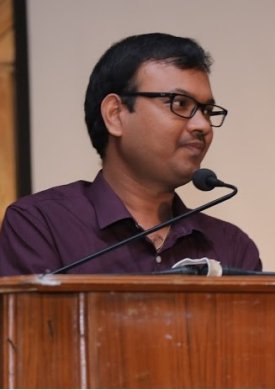 Shankar Rao Gandham 'Music for Annamayya kritis' by Shankar Rao Gandham, a young researcher, orator and scholar on Annamayya literature was enlightening. His quest helped in unearthing 300 plus new sankeertanas of Annamayya and his family from Saraswati Mahal Library, Tanjavur, and SV Oriental Research Institute,Tirupati. He has authored Annamayya Padaamritavarshini and Annamayya Padamandaakini in which he rendered the commentary for 500 sankeertanas. S. Venumadhav, who has been given the rare honour of singing Annamayya's Dasavatara Suladi in the original notation of Annamayya as found in the Tirumala Music Inscriptions engraved on stone slabs at the Tirumala hill, was aptly the chair for this session. Gandham said 600 years ago, Annamayya created incomparable wealth with his contribution to Telugu land. His talk touched upon how music was in India before Annamayya, how music evolved after that and how his family carry it forward, the contemporary use of Annamayya kritis and how it is used in dance. Gandham's research has expanded to the field of Kuchipudi traditional dance also. 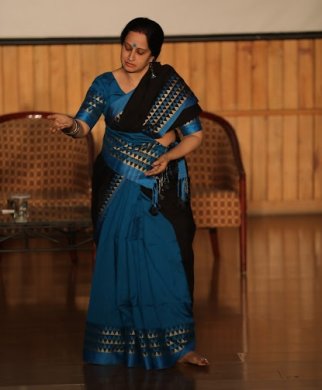 Demo by Anupama Kylash Gandham said Annamayya sangeetam was a revolutionary art form in the 15th century. He composed 32,000 songs and was the first saint composer of south India. He composed the constructive form of sankeertana. Before him, there was no such constructive format. Annamayya authored a work Sankeertana Lakshanam where he mentioned the principles to be followed to create a sankeertana. His literary works are well blended with music and dance and he thus fulfilled the art form of sankeertan, offering thousands of sankeertanas to Lord Venkateswara. Dancer Anupama Kylash presented dance glimpses of an Annamayya composition in raga Kondamalahari put to music by Balantrapu Rajinikantha Rao. Elaborating on the sankeertanas, Gandham said those engraved on copper plates mention only the raga but no notation, perhaps because engraving 32,000 songs is itself a huge task. But the Dasavatara Suladi in Sanskrit is engraved on stone along with notations and an excerpt of this was sung by Venumadhav, who said all avatars in this Suladi are based on Mayamalavagowla, though the raga we use now as Mayamalavagowla is slightly different from the times of Annamayya. It was stressed that whatever ragam and bhavam Annamayya chose,we must adapt suitably to present times. Ananda Shankar Jayant danced an excerpt from her Sringara Darpanam. It was interesting to learn that from Annamayya's poems, there is evidence that he has seen Bhamakalapam in the 15th century! Annamayya's literary journey continued with a mix of Marga and Desi styles which also covered elapatalu (folklores), tummedapatalu, soolaadulu, vaakovaakyaalu (argument songs), yugalaalu (duets), and yakshagana prabhandhas. Unfortunately, Annamayya did not leave behind a disciple to carry his work forward. To sum up, Gandham said 14,000 of Annamayya's sankeertanas are available now. Based on sahityam, dancers use the keertanas. About 1500 have been set to music by stalwarts of which 30 to 40% have been used in dance. But he warned that Annamayya has used village dialect so one needs a dictionary to understand the lyrics! 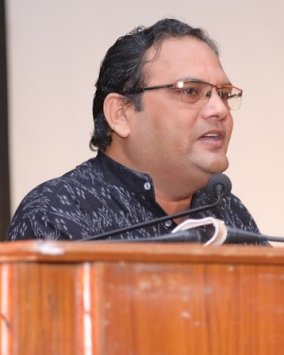 Kedar Mishra 'Odissi Music: Evolution and nuances' by Pt Ramhari Das (founder of the Ramahari Das Odissi Gurukul for training in Odissi music), accompanied by mardala maestro Pt Dhaneswar Swain was a sublime finale of the morning. The chair was poet / journalist Kedar Mishra who introduced the proceedings. He said while Guru Kelucharan Mohapatra is celebrated everywhere for his contribution to Odissi, no one knows of Pt Bhubaneswar Mishra, who scored much of the music for his Odissi choreographies. Mishra was Kelubabu's shadow. He sacrificed his career to compose Odissi music. The most difficult part for a musician is he has to sacrifice to make the diva. Later, the same thing happened to Pt Raghunath Panigrahi too. Kedar said there is music for everything in Odisha and Odissi is now in the experimenting stage. Introducing the artistes, Kedar said Ramhari Das, who was associated with Pt Balkrushna Das as well as Pt Bhubaneswar Mishra, does not sing anymore for dance but is a composer for dance. 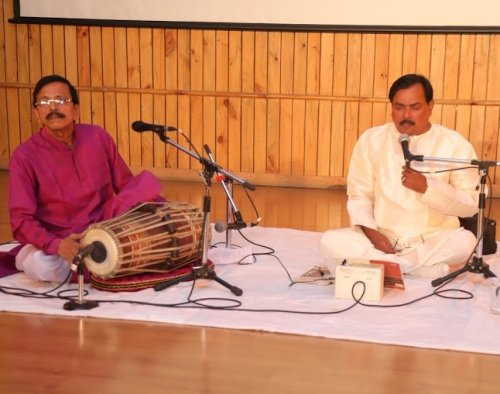 Pt Dhaneswar Swain and Pt Ramhari Das "We are for ever grateful to gurus Debaprasad Das, Pankaj Charan Das and Kelucharan Mohapatra for their contribution to Odissi dance," began Pt Ramhari Das as he elaborated on the various dance items in the Odissi repertoire. An Odissi Pallavi is a popular item and there are 160 kinds of Pallavi. A Geeta Govinda composition is also a must for most dance performances. A typical Odissi performance features Mangalacharan, Sthayi or Batu, Pallavi, Abhinaya and Mokshya. Mangalacharan has been utterly standardised into bhumi pranam and sabha pranam with an entry sloka. Mangalacharan has developed over the years into the present format. There's a slight difference in music for Sthayi depending on the guru. Demonstrating the Sthayi of the 3 stalwarts, Ramhari Das said nobody has tampered with them till date. Newer gurus like Durga Charan Ranbir, Bichitrananda Swain have had bols (like the bols of Kathak) composed by Dhaneswar Swain. An excerpt from Bichitrananda Swain's Taal Madhurya was real music to the ears! Earlier, gotipuas did a simple form of pallavi. Early pallavis used old tunes. "It was Pt Bhubaneswar Mishra who did extensive work in composing pallavis. He and Kelubabu took Odissi music to a different level. Pallavi for singing and dance are the same but there are slight changes for dance. Important is that the feel of pallavi should be there," emphasized Ramhari Das. Abhinaya item should be with bhaav and taal. Poets of the 15th to 18th centuries wrote many varieties of songs and some poets have also specified the raga to be used but the interpretation is different with different musicians. Odissi is actually a kind of song that has given the name to Odissi music and Odissi dance! Ramhari Das mentioned the various types of music like champu, chhanda, chautisa, chaupadi, janana etc. Baldev Rath composed a champu each line starting with an alphabet. Chhanda has 11 lines in each stanza. Talking of Chhandan Yatra and Jhoolan Yatra, the duo demonstrated a few lines of song sung at each stage of the idol's yatra around the temple tank. Coming to the final Odissi dance item Mokshya, Ramhari Das rued that Odissi music has now become experimental. With the sprouting of many dance schools, there is a need to put more dancers on stage. Odissi music is classical with its own science, technique and grammar. So any kind of musical blend makes it neo-classical. Nowadays even classical Carnatic music is being used! The visualization and the music composed for that should be suitable. Visualization being most important for a music composer, Ramhari Das said Pankaj Charan Das and Balkrushna Das excelled in that. The duo had more to share, but it was soon time for Kedar Mishra to sum up the proceedings. "Every song and dance goes with its cultural movements. So when other genres of music are used, the nuances are missed - like using Bharatanatyam music for Odissi. Given its socio-cultural milieu, Odissi has its own identity." The mellifluous singing of Pt Ramhari Das and the authoritative mardala of a smiling Pt Dhaneswar Swain charmed the rasikas no end. Nartanam Conclave 2018 on Music in Dance: Part 2 Lalitha Venkat is the content editor of www.narthaki.com |